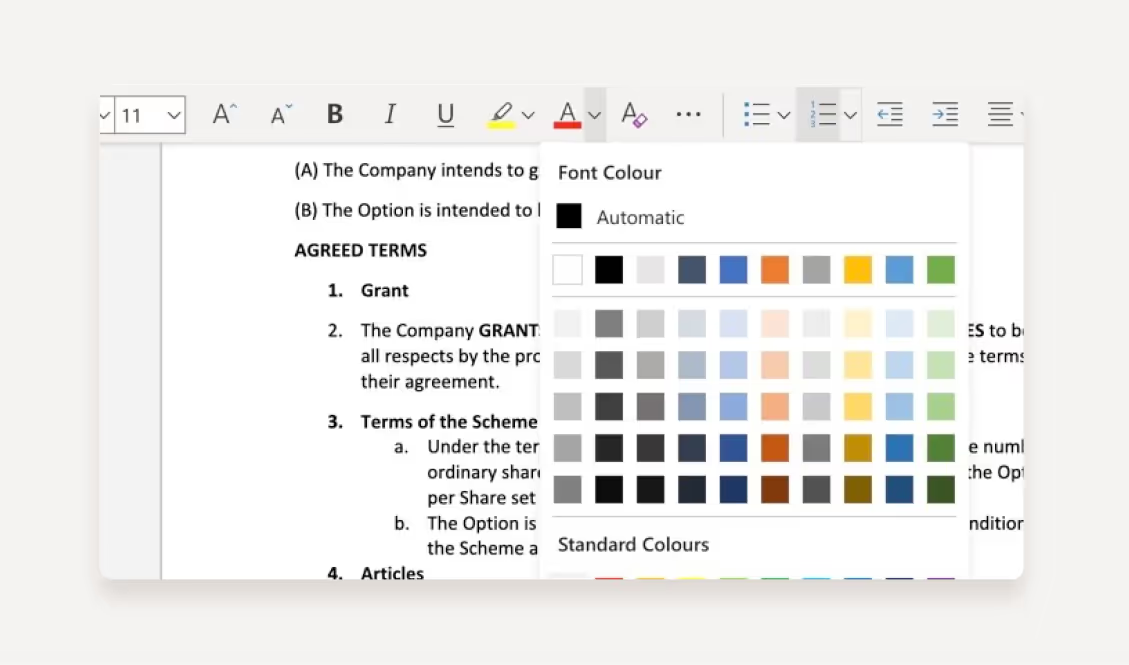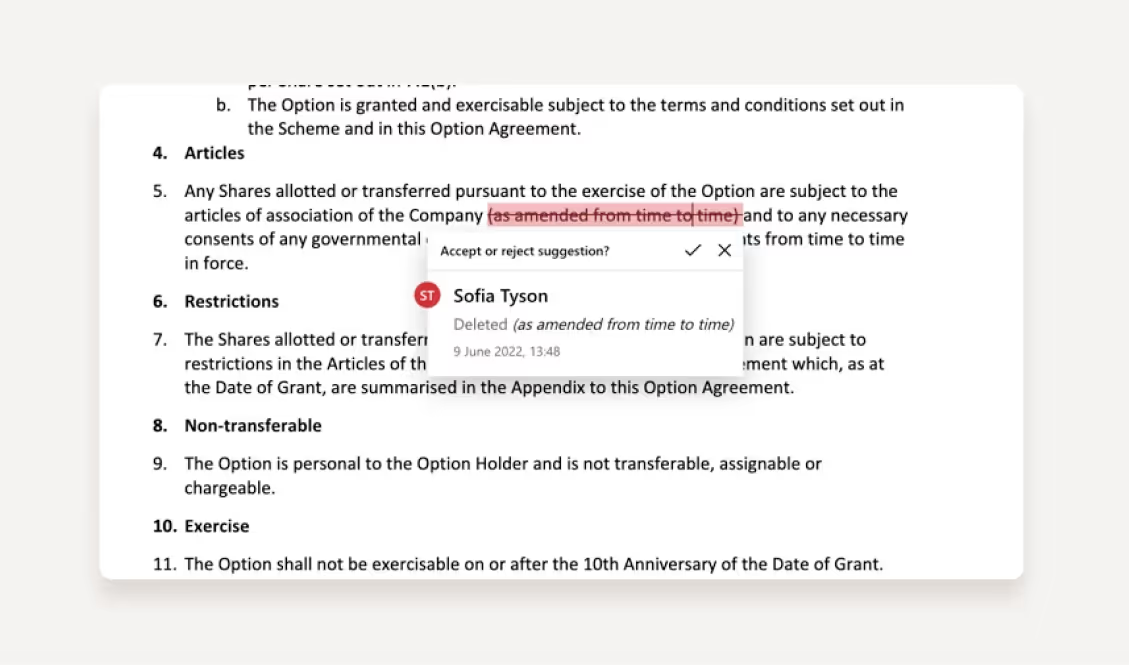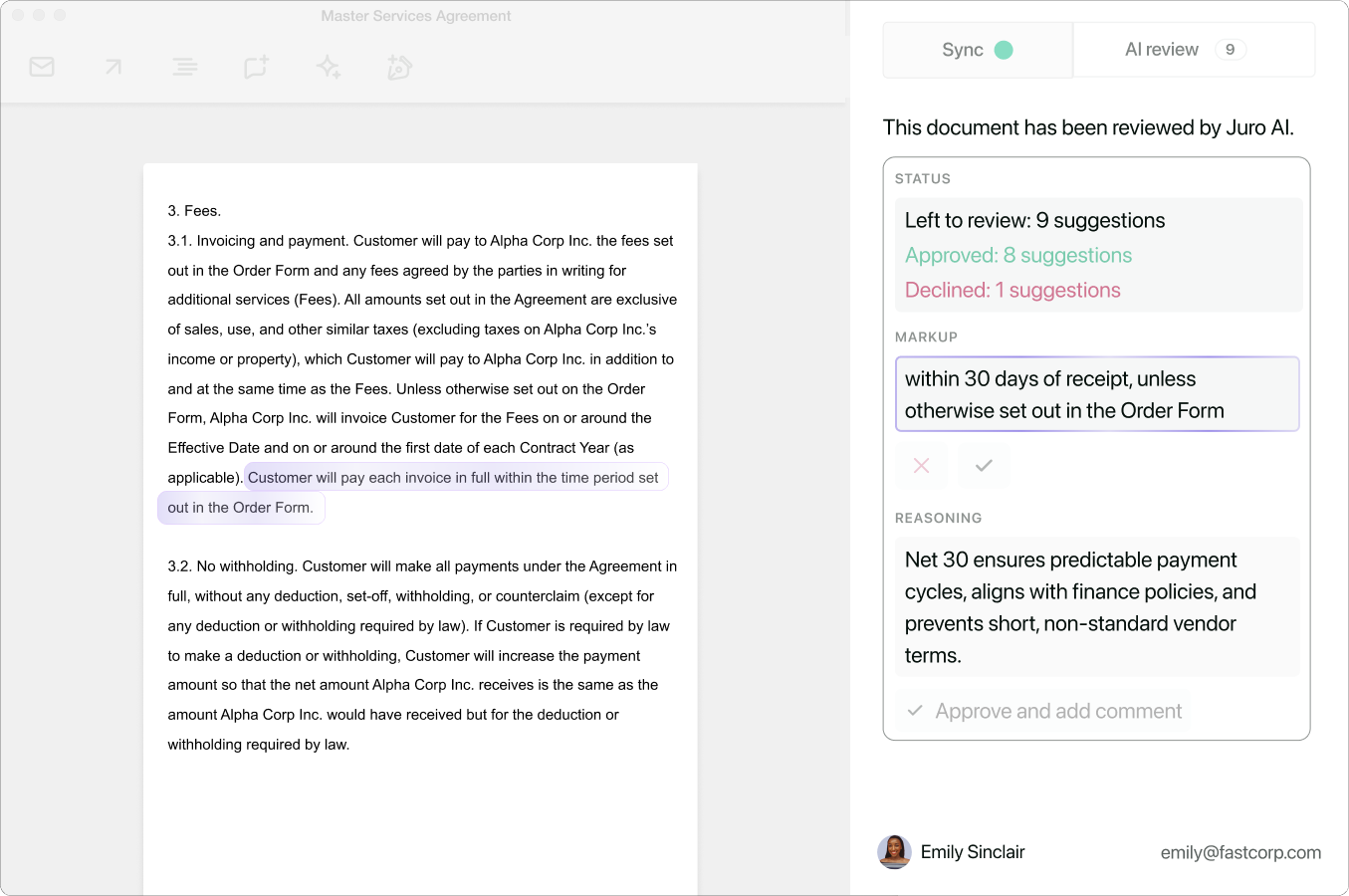Solutions
Customer Support
Resources


Microsoft Word has been the default currency for contracts for decades. Any lawyer that’s ever pushed a contract through revisions will have redlined in Word - or at least tried to.
But familiarity doesn’t get contracts negotiated faster, efficiency does. And there are certainly more efficient ways to redline contracts in 2025.
This Juro guide explains how to redline a Word document, and how you can make your current redlining process better.
Redlining in Microsoft Word is a feature that enables users to remove, add or edit text within a Word document, with the changes marked up in red.
When users choose to delete text within the document, the feature adds a red strike through all of the deleted words. If users decide to add words to the document, this red line will appear under the new text to indicate that it’s been suggested.

Each redline will then also connect the suggestions made to a specific individual, making it easy to see who has proposed which changes and when.
The purpose of redlining in Word is to make any adjustments and edits visible to all parties, and to enable users to propose changes directly within a file without making irreversible changes to the initial document.
There are a few different ways to redline in Word, with some more advanced and intuitive than others. Let's run through the main ways to redline in Word now, starting with the manual approach.
You can redline a document manually in Word by using strikethrough for deletions and red text for additions. This method is more tedious than using track changes but still gets the job done.

A more efficient way to redline in Word is by using the Track Changes feature:

If you receive a document with Track Changes, you’ll need to review and approve or reject the edits. Here’s how:

While redlining in Word follows a clear process, the software wasn’t designed for contract management.
We hear from customers daily about their experiences before using Juro. For many, Word is just one of the many tools they have to switch between to finalize even the simplest contracts. Put simply, managing contracts in Word creates inefficiencies and delays throughout the contract process.
.avif)
The core issue is a lack of centralization. You can add redlines in Word, but it doesn't offer a comprehensive solution for signing, storing, tracking, or organizing contracts beyond that point.
Pre-Juro, we followed a very manual process. Everything was spread between email and Word, with back and forth meetings to agree contracts; and we had nowhere to store or access these centrally” - Samara Doobay, Legal Counsel, Entourage
On top of that, accepting or rejecting redlines is not the same as actually approving a contract. Those who rely on Word often find themselves in one of two situations: contracts are either shared with counterparties too early, or they’re buried in stakeholders' inboxes, waiting for approval. Both are bad.
Sales had to wait much longer for legal to draft a contract, and often chased us to speed up the process. Approvals were also really manual - everything took place over email” - Alicja Kwiatkowski, Head of Legal, Iptor
Finally, Word offers limited controls to ensure only pre-approved terms are used. Commercial teams often self-serve with static templates that may be outdated or unsuitable for their needs, and legal lack visibility when this happens.
Fortunately, there's a better way...
But did you know you can actually automate the contract redlining process in Word by using contract review software like Juro?
Juro’s AI Review Agent for Word makes contract redlining faster, smarter, and safer by embedding AI intelligence into the Microsoft Word environment your counterparties already use.

Here's how it works:
Instead of manually checking every clause, legal can review and apply AI-suggested redlines in seconds. Better yet, once redlines or comments are made in Word, they’re automatically synced back to Juro—creating a single source of truth with full version control. You'll also benefit from end-to-end contract management functionality, enabling you to standardize contracting and reduce risk at every stage.
With Juro’s AI Review Agent for Word, you get the best of both worlds: the familiarity of Word for counterparties and the control, compliance, and speed of Juro’s AI-powered contracting platform.
To see it in action, book a personalized demo below.
Juro embeds contracting in the tools business teams use every day, so they can agree and manage contracts end-to-end - while legal stays in control.


Sofia Tyson is the Senior Content Manager at Juro, where she has spent years as a legal content strategist and writer, specializing in legal tech and contract management.
Sofia has a Bachelor of Laws (LLB) from the University of Leeds School of Law where she studied the intersection of law and technology in detail and received the Hughes Discretionary Award for outstanding performance. Following her degree, Sofia's legal research on GDPR consent requirements was published in established law journals and hosted on HeinOnline, and she has spent the last five years researching and writing about contract processes and technology.
Before joining Juro, Sofia gained hands-on experience through short work placements at leading international law firms, including Allen & Overy. She also completed the Sutton Trust’s Pathways to Law and Pathways to Law Plus programs over the course of five years, building a deep understanding of the legal landscape and completing pro-bono legal volunteering.
Sofia is passionate about making the legal profession more accessible, and she has appeared in several publications discussing alternative legal careers.

Juro embeds contracting in the tools business teams use every day, so they can agree and manage contracts end-to-end - while legal stays in control.
Book your demo